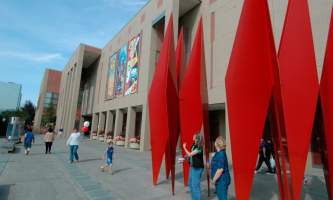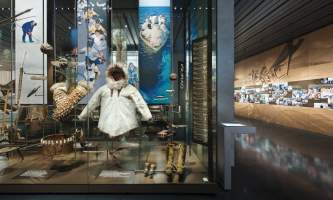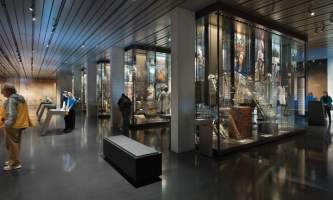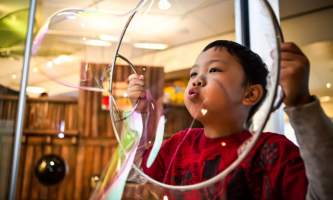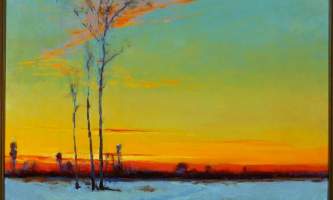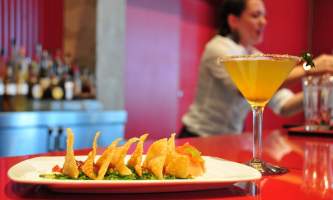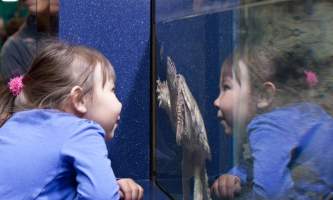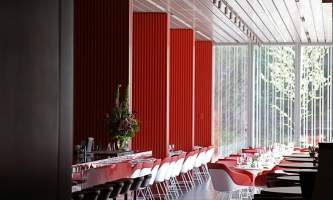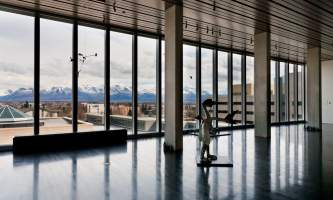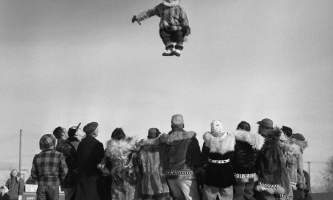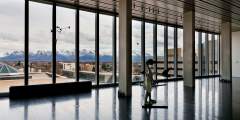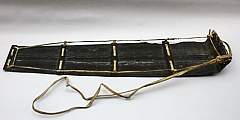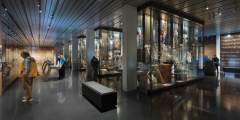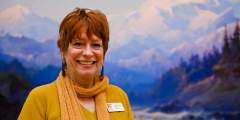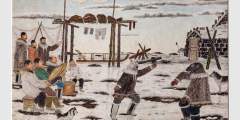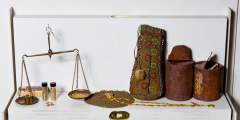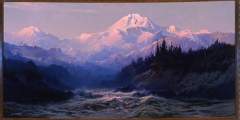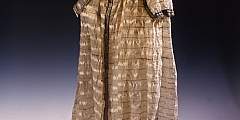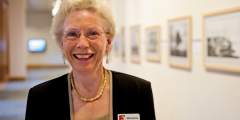There’s no better place to get a grasp on Alaska’s history—really, its many histories— than by visiting the Anchorage Museum at Rasmuson Center. The state’s largest museum is truly a world-class experience, offering a compelling overview of Alaskan history, art, culture, and science. Get the dirt on the gold rush, learn how Alaska’s earliest people survived sub-zero temperatures, see the result of North America’s biggest earthquake, and much more. It’s fascinating fun for the whole family.
Alaska’s History & More
Right downtown, the Anchorage Museum tells the story of the north—from Alaska’s history, art, and culture to the wonder and challenges of living in Alaska. This overview is the perfect way to begin your Alaskan experience. Start with over 600 objects from Alaska Native cultures, on loan from the Smithsonian Institution, that bring the state’s varied indigenous cultures to life. Artifacts include ceremonial masks, battle armor, and waterproof clothing made from seal intestines. Watch short films and see photographs that show what being Alaska Native means today, and how traditions are being carried into the future.
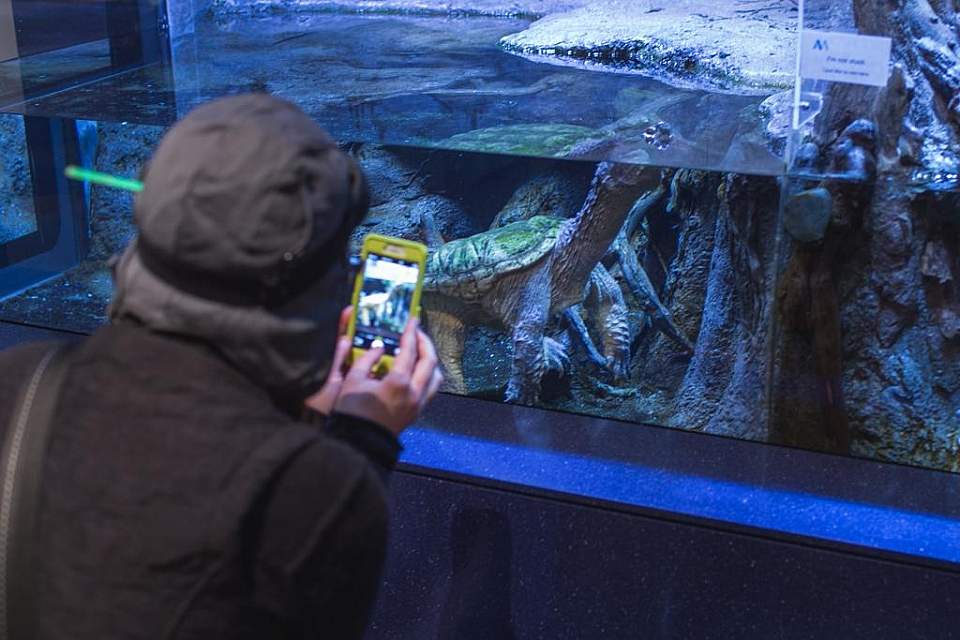
The museum’s interactive Discovery Center has something for everyone
The museum—which officially opened in 1968—is also a hands-on discovery center that’s perfect for children. The 80 kid-friendly science exhibits in the Discovery Center include a sea life tank and small planetarium, where you can see winter’s Northern Lights even in summer.
Plan Your Visit
You could easily spend four hours enjoying the museum, but even two hours will let you see the highlights. In summer, take one of the free daily tours led by engaging docents, watch demonstrations in the science center, and on Tuesdays grab lunch from a food truck and have lunch on the lawn. Year-round, you’ll find scientific and culture presentations with book signings, evening events, classes, and workshops. And there’s always a revolving exhibition or two.
One spot not to miss: the Rasmuson Wing. This new area, which opened in 2017, is named for the Alaskan family that helped create the museum and whose members have been a driving force behind its success. The new wing massively increased the space available to display the museum’s impressive collection in the Art of the North, which combines indigenous works with other traditional, modern, and contemporary works, making for a compelling—and very Alaskan—narrative.
Permanent Exhibits
Living Our Cultures: At the Smithsonian Arctic Studies Center, this is the largest and longest running of any Smithsonian institution loan anywhere in the world.
Alaska Exhibition: Hear the story of Alaska through multiple perspectives in an engaging, interactive way. Explore 360-degree views of popular Alaskan hot spots or build your own community on a huge screen by adding in people, symbols, structures, and animals.
Art of the North: This contemporary art gallery is filled with art and sculpture from iconic Alaskan artists.
Dining & Shopping
Muse: Bountiful, hearty, healthy food – Alaska Style
Anchorage Museum’s full-service restaurant features menu offerings from small bites to full-course meals. Casual with a contemporary vibe.
Atrium Café: Coffee bar with snacks, desserts, and quick bites, as well as coffee, wine, and beer.
Store: This is not your usual museum store. They work with local, native artists to carry unique items that spark a sense of wonder—things you simply can’t find anywhere else in the state. Shop for locally made contemporary jewelry, Alaska Native carvings, museum-designed shirts, hydroflasks, ornaments, Qivuit and silk ties with Southeast Alaska designs, books about Alaska, kids’ toys and puzzles, and much more.
Prices & Dates
| Season | Year Round |
| Rates | Adults // $25 |
| Alaska Residents // $20 | |
| Senior / Military / Student (with ID) // $18 | |
| Children 6-12 // $12 | |
| Children 0-5 // free | |
| Private Docent Fee // $200 | |
| Hours | Museum // Please check the website for current open days and hours of operation. www.anchoragemuseum.org |
| Muse Restaurant // Open 11:30am to 6pm daily May 1st - Oct 1st |
Show Map
Anchorage Museum Audio Guide
This temporary exhibition space also offers dramatic views of the Chugach Mountains, the 250-mile mountain range that embraces Anchorage’s eastern edge.The museum first opened in 1968 and has expanded three times over the past four decades. Anchorage celebrated the grand opening of the museum’s most recent expansion, a four-story west wing with a shimmering glass façade, in 2010. The stunning addition was designed by London architect David… ...more
In Alaska, most whale species don’t have teeth. Instead they grow up to 13-feet-long keratin plates, or baleen, which act like a giant sieve to capture plankton. Iñupiaq whalers discovered the wonderful properties of this sturdy, frost-resistant material. They used heat or urine to soften the baleen, then turned it into fishing nets, lashing and sled runners. Sleds like this early 20th century version were used to transport seals from icepack… ...more
Video, audio and rare artifacts converge to create an unforgettable overview of Alaska Native culture. Marvel at 600 Alaska Native objects on loan from the Smithsonian Institution, including a Tlingit warrior’s helmet, Inupiaq whale hunting tools, and a hand-sewn Yup’ik parka made from 93 ground squirrels. Hear Alaska Native languages and see glimpses of contemporary life.
New York artist Rockwell Kent and his 9‑year-old son spent the winter of 1918 on Fox Island near Seward. They were thrust out of their comfort zone, living in a goat shelter that was a 12-mile boat ride from the nearest village. Kent painted this scene nearly 50 years later from sketches of that adventure. The redemptive glow of the sun and two human figures reflect his emotional journey in the Alaska wilderness.
Inupiaq artist James Kivetoruk Moses grew up hunting, trapping and working as a reindeer herder. In 1953, a knee injury made his traditional subsistence lifestyle impossible, so he began his celebrated art career. This painting illustrates a dance competition between two men during Messenger Feast, a month-long festival.
Scores of optimistic gold prospectors stampeded north to Alaska after 1880, seeing the Last Frontier as a place of potential wealth, great adventure and a second chance. Extracting gold from Alaska’s rugged terrain amid brutal elements was hard work — and could be deadly for the unprepared. This exhibit tells miners’ stories using photographs, artifacts and, of course, gold.
At 20,320 feet, Denali (Mt. McKinley) is the tallest mountain in North America; so tall, clouds often conceal it. But there’s always a great view of it at the museum thanks to beloved Alaska painter Sydney Laurence. He created this 13-by‑8 foot painting in 1929 to capture the immensity of the Last Frontier.
Centuries before Gore-Tex was invented, Unangax hunters stayed dry by wearing waterproof parkas made from marine mammal intestines. In the 19th century, Russian naval officers commissioned gut capes like this one, patterned after their naval uniforms. A skillful Unangax seamstress would need six months or more to sew such a cape.
Natural resources have been central to Alaska’s economic success. The fur trade in the late 18th/early 19th centuries, gold rushes in the late 19th and early 20th centuries, and oil since the mid-20th century have been key in Alaska’s development. The 1968 discovery of oil in Prudhoe Bay, the largest reservoir of oil in North America, led to the construction of the trans-Alaska pipeline.


